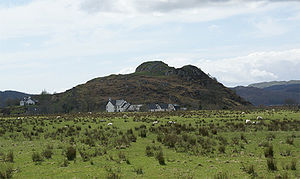Dunadd
| Dunadd Hillfort | |
|---|---|
| Kilmartin, Argyll, Scotland, United Kingdom | |

Dunadd Hillfort Crag
|
|
| Coordinates | 56°05′10″N 5°28′43″W / 56.08611°N 5.47861°W |
| Type | Hillfort |
| Site information | |
| Open to the public |
Yes |
| Condition | Ruin |
| Site history | |
| In use | Ironage–16th Century C.E. |
| Materials | Stone |
Dunadd (Scottish Gaelic Dùn Ad, 'fort on the [River] Add') is an Iron Age and later hillfort near Kilmartin in Argyll and Bute, Scotland and believed to be the capital of the ancient kingdom of Dál Riata.
Dunadd is a rocky crag that may have been one time an island and now lies inland near the River Add, from which it takes its name, a little north of Lochgilphead (NR 836 936). The surrounding land, now largely reclaimed, was formerly boggy and known as the Mòine Mhòr 'Great Moss' in Gaelic. This no doubt increased the defensive potential of the site. Detailed analysis of sea-level changes in the region argue that the Dun was an island or promontory into historic times, and that receding sea levels left the fortification open to siege and seizure in the 6th to 7th centuries
Originally occupied in the Iron Age, the site later became a seat of the kings of Dál Riata. It is known for its unique stone carvings below the upper enclosure, including a footprint and basin thought to have formed part of Dál Riata's coronation ritual. On the same flat outcrop of rock is an incised boar in Pictish style, and an inscription in the ogham script. The inscription is read as referring to a Finn Manach and is dated to the late 8th century or after.
Dunadd is mentioned twice in early sources. In 683 the Annals of Ulster record: "The siege of Dún At and the siege of Dún Duirn" without further comment on the outcome or participants. In the same chronicle the entry for 736 states: "Aengus son of Fergus, king of the Picts, laid waste the territory of Dál Riata and seized Dún At and burned Creic and bound in chains two sons of Selbach, i.e. Donngal and Feradach."
...
Wikipedia
